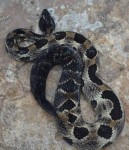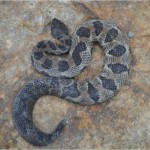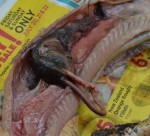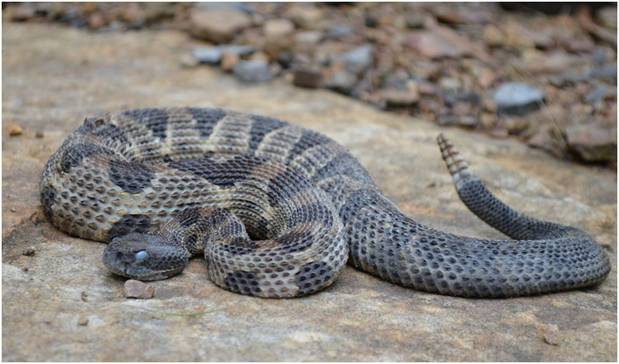 This year, 2012, has been an exciting time for the Timber rattlesnake population and reproductive assessment survey research. The driving force behind this project was to better understand how human presence in the north eastern part of their range has affected overall rattlesnake numbers and breeding success compared to previous data. In addition, we wanted to learn more about Timber rattlesnake behavior so that we can educate the public and help them better appreciate the importance of this magnificent snake.
This year, 2012, has been an exciting time for the Timber rattlesnake population and reproductive assessment survey research. The driving force behind this project was to better understand how human presence in the north eastern part of their range has affected overall rattlesnake numbers and breeding success compared to previous data. In addition, we wanted to learn more about Timber rattlesnake behavior so that we can educate the public and help them better appreciate the importance of this magnificent snake.
Having begun this project in 2011, it was a frustrating year as all the specimens we were finding had been killed by people. It was heartbreaking to find that the Timber rattler was not even protected within state parks as most dead snakes were purposefully killed by automobiles in roadways where speed limits were restricted to less than 15 miles per hour and by visitors who would stray substantial distances from posted hiking trails. If you are afraid of interacting with wildlife then why come to a state or national park? To add insult to injury, it appeared that a few employed to manage parks were just as fearful of snakes and in some cases the ones killing them.
been killed by people. It was heartbreaking to find that the Timber rattler was not even protected within state parks as most dead snakes were purposefully killed by automobiles in roadways where speed limits were restricted to less than 15 miles per hour and by visitors who would stray substantial distances from posted hiking trails. If you are afraid of interacting with wildlife then why come to a state or national park? To add insult to injury, it appeared that a few employed to manage parks were just as fearful of snakes and in some cases the ones killing them.
 Since May, we have successfully identified 10 research sites and 14 snakes ranging in age from 1 to 10+ years including males and gravid (pregnant) females. We have also been successful in identifying snakes that have been caught previously via variations in patterns and colors, scars, imperfections, and/or painted rattles. It is our hope that in the future we can also incorporate microchipping as a form of identification.
Since May, we have successfully identified 10 research sites and 14 snakes ranging in age from 1 to 10+ years including males and gravid (pregnant) females. We have also been successful in identifying snakes that have been caught previously via variations in patterns and colors, scars, imperfections, and/or painted rattles. It is our hope that in the future we can also incorporate microchipping as a form of identification.
Compared to historical data, the Timber rattlesnake population has dropped dramatically. It is a common misconception that this species is very prolific. In their northern most range, the Timber rattler may not breed until after she is 5-7 years old and will only give birth to 3-5 live young only twice her entire life. If we take this into consideration we can see how the constant persecution of this snake can quickly lead to its demise. And considering that each rattlesnake can eat several rodents a month, this is a creature we desperately need to learn to live with. It is to our absolute delight that we have two pregnant females. Currently, we are on the lookout for newborns.
Regarding behavior, the learning curve has been incredible. Please know that we handle these snakes in the most noninvasive way possible and only because we are trained professionals. In our experience, the Timber rattler is a nonaggressive species. They are quick to calm down after being handled and are very reluctant to strike. This species will use threat displays of tail rattling, hissing, and body posturing (inflating and flattening the body to look bigger) followed by an attempt to flee almost every time. I say this only to shed light on the misconception that the Timber rattler is a mean, ugly monster that will go out of its way to bite a human, and not as encouragement for others to directly interact with them. You should enjoy all snakes from a safe distance. In addition, in at least two sites, rattlesnakes were found coinhabiting with other snake
snakes in the most noninvasive way possible and only because we are trained professionals. In our experience, the Timber rattler is a nonaggressive species. They are quick to calm down after being handled and are very reluctant to strike. This species will use threat displays of tail rattling, hissing, and body posturing (inflating and flattening the body to look bigger) followed by an attempt to flee almost every time. I say this only to shed light on the misconception that the Timber rattler is a mean, ugly monster that will go out of its way to bite a human, and not as encouragement for others to directly interact with them. You should enjoy all snakes from a safe distance. In addition, in at least two sites, rattlesnakes were found coinhabiting with other snake  species such as Northern copperheads, garter snakes, and black rat snakes. Debunking yet another wives tale that nonvenomous snakes will displace venomous snakes.
species such as Northern copperheads, garter snakes, and black rat snakes. Debunking yet another wives tale that nonvenomous snakes will displace venomous snakes.
One of our research subjects was a male that appeared to have lesions around his face and a mass inside of his mouth. He presented with a slight neurological disorder, would try to hide his head within his coils, and did not make any attempt to rattle. Although no tissue samples were collected initially, pictures were sent to a veterinarian specializing in a fungal infection that has just recently been documented in wild snakes called Chrysosporium. From the pictures it is clear to see that this individual has the stereotypical signs of this condition. Sadly, Crysosporium has a 100% mortality rate in sick snakes. A soil borne fungus, Chrysosporium is common in captive snakes. However, it is unclear how wild snakes are contracting this illness. To date, there have been Massasauga and Timber rattlers in 4 states documented with this fungus.
 On a related note, we were recently given two deceased Timber rattlesnakes for necropsy. This was certainly a first for us. These snakes had been frozen for 25 years. They were originally killed out of fear and kept for their skins. Turning a negative into a positive, I decided to perform a necropsy on both snakes so that we could use what we learn as part of our education program. This procedure was documented via video and pictures and will available in a few weeks. As a reproductive physiologist, I found the the reproductive tract physiology amazing. It was unlike any species I have studies thus far. In addition, we got quite a shock when we found a fully intact field mouse in the stomach of one of the snakes. A meal that was ingested only hours before the snake was killed and literally frozen in time for over 2 decades!
On a related note, we were recently given two deceased Timber rattlesnakes for necropsy. This was certainly a first for us. These snakes had been frozen for 25 years. They were originally killed out of fear and kept for their skins. Turning a negative into a positive, I decided to perform a necropsy on both snakes so that we could use what we learn as part of our education program. This procedure was documented via video and pictures and will available in a few weeks. As a reproductive physiologist, I found the the reproductive tract physiology amazing. It was unlike any species I have studies thus far. In addition, we got quite a shock when we found a fully intact field mouse in the stomach of one of the snakes. A meal that was ingested only hours before the snake was killed and literally frozen in time for over 2 decades!
